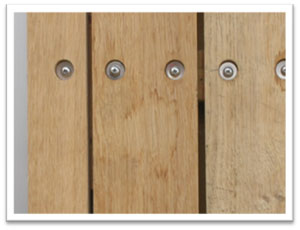External Cladding : Fixing Information for External Timber Cladding - Hardwood
Normally in cladding you would fix hardwood boards to treated softwood fixing battens. It is advisable despite location to have the holes in your timber boards pre-drilled, that clearance is provided about the screw and allows for seasonal variation of moisture content. Due to these variations large diameter screws with big heads are preferred but the head of a countersunk screw should provide enough retention. But restricting the board width to 150mm and placing a screw at each quarter point of the diameter should limit the amount of wood that swells or shrinks in the cladding. There should a 2mm clearance between the shank of the screw and the hole in the timber boards when using small and medium woods to allow for 16% moisture content.

Considerable shrinkages can be expected between the fixings if green / fresh sawn wood is used, such as our Fresh Sawn Character Quality Oak Cladding during the initial drying stage. We advise in this case to pre drill the boards to provide at least 4mm clearance in between the screws shank and the hole. It will then be necessary to fit washers because the screws head won’t be big enough to hold the board. Washers can be installed to allow them to move with the green wood, but care must be taken when aligning them up with the slots. This is because you want the screw initially to be on the outer ends of the slots. As an alternative washers’ can be drilled into the timber board to allow them to move with the wood in the cladding. You would normally use washers with round head and pan head screws but there are various sheeting screws with built in washers which have been used effectively on green wood. The use of large screws with metal washers by screwing through the back of the batons can have the desired effect of concealing the fixings in the cladding. It is plausible get enough screw retention in the thickness of a hardwood board but this is not possible when using softwood. If you are using softwood then you need to have sufficient clearance holes in the batons rather than in the boards. The completed panels can then be added to the face of the cladding by screwing back the batons through open joints or screwing straight through the boards and then pelleting around the holes.
There is another method of concealing fixings on horizontal boards which is to mount the timber boards onto U-shaped stainless steel clips used on the vertical batons. You then screw through the rebated upstand to hold the top of the board. This is similar to tongued and grooved boarding but the upstand is long enough to allow for shrinkage in the board which means that the tongue is less likely to get damaged. Another advantage is that a single clip is all that is required to hold the bottom abutting boards to the vertical baton. This system is suited to both shiplap and open jointed however the clip system requires a lot of designing and planning, with things like species, likely shrinkage, thickness of board and other things are all taken into account.
Austenitic stainless steel screws should be used in the cladding when fixing unfinished wood and any washers or clips used should be of the same material. Stainless steel screws are also preferable when the boards are painted or stained because plated screws can become damaged during installation, resulting in corrosion and consequently will stain the timber. You may need to have wood batons between boards and a metal frame because if you don’t then the steel might have an electrolyte action with the metal. The boards can then be fixed with stainless steel screws whereas the batons can be screwed to the frame using plated screws or bolts. Fixing directly to steel is particularly a problem because it could cause mild steel swarf which in turn will cause corrosion which will result in Iron staining as well as an electrolyte reaction.







 Main Menu
Main Menu

